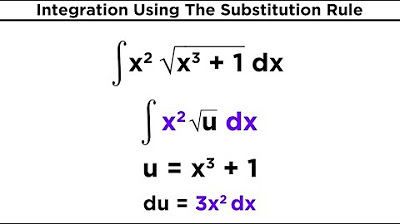_-substitution: defining _ (more examples) | AP Calculus AB | Khan Academy
TLDRThe video script focuses on the application of u-substitution in solving integrals, specifically highlighting the process of identifying suitable functions and their derivatives for substitution. It demonstrates the technique with two examples: the integral of the natural log of x to the 10th power and the integral of tangent of x. The script illustrates how to transform the integrals into a form where u-substitution can be applied, simplifies the expressions, and emphasizes the importance of back-substitution to find the final result.
Takeaways
- 📚 The video focuses on practicing the method of u-substitution for solving integrals.
- 🔍 U-substitution is applicable when there's a function and its derivative involved in the integral.
- 🌟 Recognizing the derivative of the function inside the integral is crucial for choosing the right u.
- 📈 An example given is the integral of natural log of x to the 10th power over x, where u is set to the natural log of x.
- 🛠 The derivative of the chosen u (in the first example, natural log of x) is used to express du/dx.
- 🧩 The integral simplifies to u to the power of 10 times du after applying u-substitution.
- 🔄 Back-substitution is used to evaluate the indefinite integral by replacing u with its original function.
- 📊 Another example is the integral of tangent of x, which is rewritten in terms of sine and cosine to apply u-substitution.
- 👉 The strategy involves multiplying by negative one to align the derivative with the form required for u-substitution.
- 📱 In the second example, u is set to cosine of x, and du/dx is negative sine of x, simplifying the integral.
- 🎯 The final step is to evaluate the simpler integral and then perform back-substitution to find the original integral's value.
Q & A
What is the main topic of the video?
-The main topic of the video is practicing the method of u-substitution in integration.
What is the first integral example given in the video?
-The first integral example is the indefinite integral of the natural log of x to the 10th power over x dx.
How is u-substitution applied in the first example?
-In the first example, u-substitution is applied by recognizing that the natural log of x to the 10th power has a derivative of one over x, leading to the substitution u = natural log of x and du = 1/x dx.
What is the significance of identifying the derivative in u-substitution?
-Identifying the derivative is crucial in u-substitution because it allows us to express the integrand in terms of u and du, simplifying the integral.
What is the second integral example discussed in the video?
-The second integral example is the integral of tangent of x dx.
How is the tangent function rewritten to apply u-substitution in the second example?
-The tangent function is rewritten in terms of sine and cosine as the integral of sine of x over cosine of x dx.
What is the key insight for choosing u in the second example?
-The key insight is recognizing that the derivative of cosine of x is negative sine of x, which leads to the substitution u = cosine of x and du = -sine of x dx.
How does the process of u-substitution simplify the integral of tangent of x dx?
-By substituting u with cosine of x and du with -sine of x dx, the integral simplifies to the negative indefinite integral of one over u, making it easier to evaluate.
What is the final step in u-substitution after evaluating the integral?
-The final step is back-substitution, where the original variable (in this case, x) replaces the u variable to find the antiderivative.
Why is u-substitution a useful technique in integration?
-U-substitution is a useful technique because it can transform complicated integrands into simpler forms that are easier to integrate, thus facilitating the solution of integrals.
What is the role of the derivative in the selection of u in u-substitution?
-The derivative plays a critical role in the selection of u because u is typically chosen to be a function whose derivative is present in the integrand, allowing for simplification through substitution.
Outlines
📚 Introduction to U-Substitution
This paragraph introduces the concept of u-substitution, a technique used in calculus for solving integrals. The instructor explains the conditions under which u-substitution can be applied, which is when there is a function and its derivative present in the integral. The example given is the indefinite integral of the natural log of x to the 10th power over x. The instructor demonstrates how to identify the function (natural log of x) and its derivative (1/x), and then proceeds to make the substitution where u is set as the natural log of x and du/dx equals 1/x. The integral is then simplified to u to the 10th power times du, which is easier to evaluate. The process of back-substitution is also mentioned, where the original variable (x) is substituted back in for u to solve the integral.
Mindmap
Keywords
💡u-substitution
💡indefinite integral
💡natural log
💡derivative
💡tangent
💡sine and cosine
💡integration by parts
💡antiderivative
💡back-substitution
💡constant of integration
💡integration properties
Highlights
The video discusses the application of u-substitution in integration.
The indefinite integral of natural log of x to the 10th power over x is used as an example.
The derivative of natural log of x is identified as one over x.
The integral is rewritten to clearly show the function and its derivative.
The substitution u equals natural log of x is suggested based on the derivative.
The du dx relationship is established as one over x.
The integral simplifies to u to the 10th power times u to the 10th power du.
Back-substitution is mentioned as a method to evaluate the indefinite integral.
The integral of tangent of x is discussed as another example.
Tangent of x is rewritten in terms of sine and cosine.
The derivative of cosine of x is identified as negative sine of x.
A method for engineering the integral by multiplying by negative one is introduced.
The substitution u equals cosine of x is proposed based on the derivative.
The du relationship is established as negative sine of x dx.
The integral simplifies to the negative indefinite integral of one over u.
The process of back-substitution is mentioned for the final evaluation of the integral.
The video provides a clear and methodical approach to using u-substitution in integration.
Transcripts
Browse More Related Video

_-substitution: definite integrals | AP Calculus AB | Khan Academy

Back Substitution - When a u-sub doesn't match cleanly!

Calculus 1: U-Substitution Examples

Definite Integrals from Graphs (Part 2 of 3) - U-Substitution

Lesson 11 - Integration By Substitution (Calculus 1 Tutor)

Integration Using The Substitution Rule
5.0 / 5 (0 votes)
Thanks for rating: